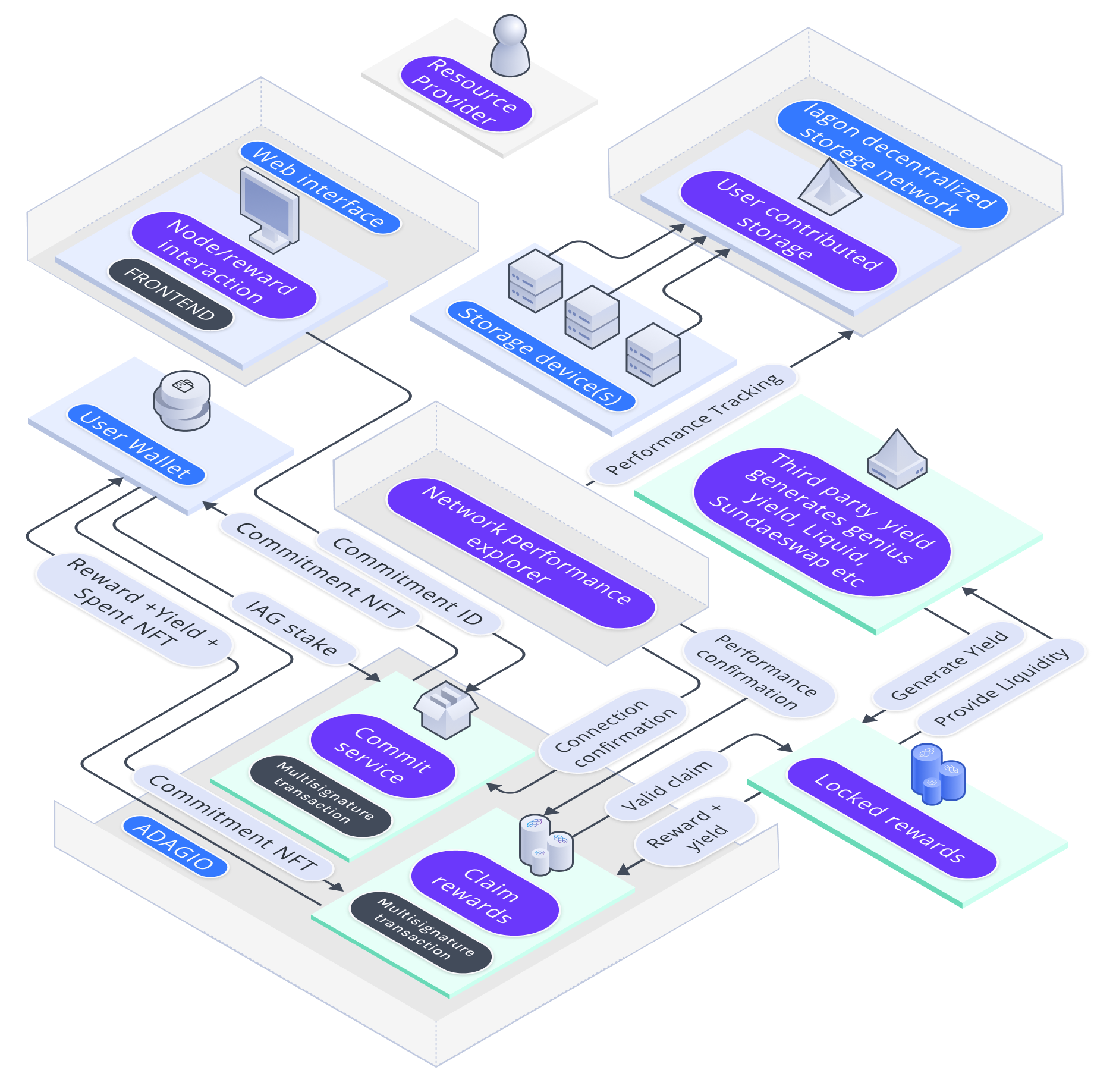Adagio
Overview
Adagio implements a rewards model for retail storage providers, connecting the storage demand of the consumers to the supply from the providers. It's goal is to reward the storage providers.
The following diagram shows how Adagio relates to the rest of the Iagon protocol:

An important feature of Adagio is that it determines the rewards when storage providers commit their resources.
The following sequence diagram is a schematic of the interactions that take place between the storage providers and Adagio:
sequenceDiagram
autonumber
participant sp as Storage Provider
participant adg as Adagio
participant mkt as Storage Marketplace
sp ->> adg: Commits storage
adg ->> sp: Verifies connection
adg ->> mkt: Reserves tokens in the markeptlace
adg ->> sp: Provides an NFT receipt
adg ->> adg: Rewards are locked,<br/>generating yield
loop
adg ->> sp: Reviews performance
end
adg ->> sp: Provides an NFT receipt <br/> and returns the rewards and yield
The flow is as follows:
- The storage provider commits storage.
- Adagio verifies the connection.
- Adagio reserves the corresponding number of tokens in the storage marketplace.
- Adagio provides an NFT receipt.
- Adagio locks rewards, generating additional yield through third-party yield optimizers such as Genius yield.
- Adagio regularly reviews the performance of the storage provider.
- At the end of the commitment period, Adagio provides the rewards and yield, as well as the NFT receipt.
Rewards
The Iagon protocol incentivizes storage providers with rewards that come from two sources:
- Stablecoins paid by storage consumers through a storage subscription model. When storage providers commit their resources to the protocol, Adagio locks rewards corresponding to the amount of storage committed and the current trading rate. During the commitment period, the locked rewards are used to generate additional yield further benefiting the resource provider.
- IAG tokens from the company treasury. A portion of the company's IAG tokens will be paid out to well-performing storage providers. See the Tokenomics section for more details.
During the lock-up period, the protocol monitors the performance of the storage providers by collecting parameters such as uptime, connection, speed, etc. The protocol uses these parameters to calculate a performance multiplier, where a value of 100% indicates a well-performing storage provider, and 0% indicates malicious behavior or poor performance. The base rewards earned by the storage provider periodically throughout the commitment period and redeemable at the end of the lock-up are calculated as follows:
Base rewards = Locked rewards * Performance multiplier
The protocol also offers additional rewards proportional to the amount of IAG tokens staked:
Dividends = Marketplace fee + Yield on locked rewards
The total rewards are the sum of the base rewards and dividends:
Total rewards = Base rewards + Dividends
The yield multiplier is based on the amount of IAG staked to the node connection as well as the degree of voluntary verification (KYC, becoming a network validator). Leaving rewards locked for longer allows for the accumulation of compounding interest. The base reward is increased periodically over the commitment period, and the yield is based on the amount of locked rewards. For example, by leaving your rewards locked, each month you add to your base reward and earn a yield on both the base reward you have collected so far as well as the yield you have earned, accumulating over time.
Tier Division
The storage providers are categorized by tiers in terms of the capability of the storage unit it provides such as storage capacity, bandwidth, storage speed, computational power and commitment period. A storage provider may offer multiple storage devices which are called Nodes. A node's capability is measured at the time it's setup and hence it's tier is determined. High tier nodes store data which in terms of centralized storage would be hosted in data centers with the emphasis on better availability and delivery of data. Tier division helps to create storage plan afforable to storage users according to their need.
Reputation Badge
The storage providers will be receive various badges providing it with an identity based upon it's performance and continuance. The reputation badges helps system to discert reliabilty of a storage provider and compute incentives that are added to the reward.
Slashing
Being a storage provider is an important responsibility, and each storage provider must meet certain standards. Slashing is the penalty for storage providers who misbehave. When a storage provider is slashed, they lose some of their rewards.